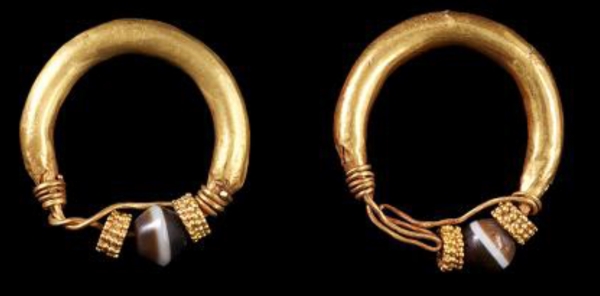
The Two Gold Bangles were crafted from gold and date back to the period between the third century BCE and the third century CE. They were used as adornments and decorative accessories and were discovered at Qaryat al-Faw Archaeological Site, located southeast of Wadi ad-Dawasir Governorate in Riyadh Province, in the Kingdom of Saudi Arabia.
Each of the two bangles features a brown agate bead, with each bead exhibiting a faint white streak. The bangles take the shape of small shields, adorned with raised dots as decorative elements arranged in four circular rows around each shield.
Dimensions of the two bangles
Each bangle has a diameter of 2.5 cm and weighs 3.25 g, with a total weight of 6.5 g. The two gold bangles are preserved at the Museum of the Archaeology Department at King Saud University in Riyadh. They were selected for display alongside other historically significant archaeological discoveries from Saudi Arabia as part of the Saudi Archeological Masterpieces Through the Ages Exhibition. Their discovery resulted from archaeological survey and excavation efforts conducted by the antiquities and museums sector in Saudi Arabia in recent years. It is among the findings of Saudi archaeologists and scientific expeditions. The two bangles are registered under number 16 F 14.
Significance of the two bangles
The two gold bangles are distinguished by their simplicity in design and the jeweler's successful fusion of gold and gemstones. The attention to adorning women with this type of jewelry and ornaments reflects the status of women. It indicates that the societies inhabiting Qaryat al-Faw experienced periods of cultural prosperity.
Related quizzes
Related articles

